Historic Snowmobile Hook-Ups

Before hooking up with Yamaha, Arctic Cat enjoyed quite a collaborative past
If you thought that the collaboration of Yamaha and Arctic Cat seemed like a big deal, you would be correct. Well, at least in recent years, as such things, while not monthly occurrences, were not altogether unheard of. But, it’s been quite a while since one sled maker joined forces with another to bring a new model to market like Yamaha is doing with its new 2014 Viper series.
Not often, but once in awhile, we find that our longevity in snowmobiling pays off. Of course, to some of the newbies in sled marketing, they probably wish it weren’t the case so they can hype their latest gizmo as being fresh and new only to be informed that, “Wait a minute, that gizmo was tried back in (pick a year).” There are darn few of us long serving veterans around now. Indeed, if you are in your 20s, snowmobiles have always been modern and if you are in your 30s trail networks always have been readily ride-able. We take modern sleds with electronic computerization and the thousands of miles of groomed trails as simply the way snowmobiling has always been. At least in our sledding lifetimes. And we understand that there have always been four major snowmobile manufacturers and that this Arctic Cat and Yamaha collaboration is unique.
HISTORY: The Yamaha Arctic Cat Collaboration
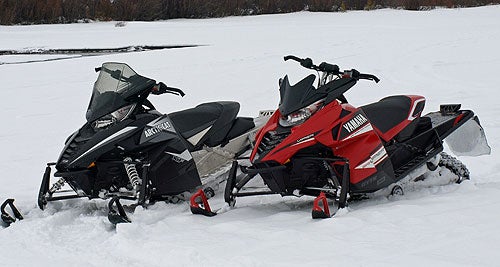 Rebranded Yamaha Viper and Arctic Cat ZR models share mechanicals but enjoy their own “looks.”
Rebranded Yamaha Viper and Arctic Cat ZR models share mechanicals but enjoy their own “looks.”Truthfully, the collaboration between these two snowmobile companies bears some true uniqueness. But, there have been plenty of historic sled hook-ups that preceded it.
Had snowmobile history gone in a slightly different path, there wouldn’t be four sled makers left from a collection of more than a hundred pioneering and wannabe builders. In fact, if events changed just ever so slightly, it’s possible only Ski-Doo and Yamaha would be left and they would be splitting the 130,000 annual sled sales.
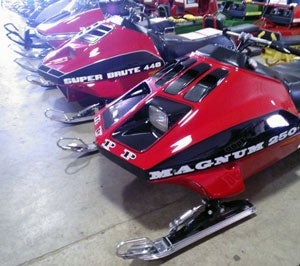 When Rupp bought the rights to the Alouette name, the two brands were essentially one in the same, except for the branding.
When Rupp bought the rights to the Alouette name, the two brands were essentially one in the same, except for the branding.As virtually all Arctic Cat enthusiasts know, Arctic Cat’s parent company went bankrupt in the early 1980s. If not for a dedicated group of ex-Arctic Cat employees, The Cat would have died nearly three decades ago. And, then there would have been only three sled makers – Ski-Doo, Yamaha and Polaris.
But, wait, about the same time Arctic Cat experienced troubles, Polaris’ corporate sugar daddy, mega-conglomerate Textron, decided to move in new more profitable directions and sell off its Roseau, Minn. snowmobile division.
In the fall of 1980 Hall Wendel Jr. served as president of Polaris. He was a Harvard MBA and the youngest man to ever head up a Textron division. But less than a year into his tenure, Textron struck a deal with Bombardier, whereby everything would remain the same with continuation of the Polaris brand, manufacturing in Roseau and marketing efforts in Minneapolis. The deal could be completed by October of 1980, but with federal authorities threatening anti-trust action and disapproval of the merger, both Textron and Bombardier backed off. Textron then allowed Wendel and a group of investors to take over the snowmobile group.
VIEW: Read our review of the 2014 Yamaha SR Viper
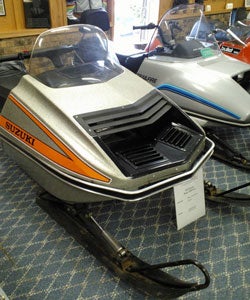 The Suzuki Fury earned a brief place in sled history as it marked the end of Kawasaki power for Arctic Cat in favor of new Suzuki “Spirit” designs.
The Suzuki Fury earned a brief place in sled history as it marked the end of Kawasaki power for Arctic Cat in favor of new Suzuki “Spirit” designs.So, had events in the early 1980s gone differently, only Ski-Doo and Yamaha would have persevered. As Wendel pointed out, the years 1979 to 1982 had been rough for the snowmobile business, he commented: “Snowmobiles were a glut on the market. The industry was making too many and selling too few. It was that simple. In 1979 the industry overbuilt in what turned out be a lousy snow year. In 1981 the country was in a recession.”
Interestingly, had Arctic Cat gone bankrupt and Polaris gone over to Bombardier, things could have gotten worse as Bombardier had its own problems, leading in 2003 to the sale of the recreational products group to a consortium of Bain Capital, the Bombardier family and Caisse de Depot & Placements of Quebec. Bain holds the largest interest in Bombardier Recreational Products (BRP) with 50 percent ownership, followed by the Bombardier family at 35 percent and Caisse de Depot & Placements of Quebec with 15 percent interest. While Ski-Doo, like Polaris snowmobiles, is the legacy product for each manufacturer, both brands could have disappeared into history, leaving only Yamaha to build sleds for today’s snowmobilers, instead of forming a partnership with Arctic Cat to build Vipers.
| Historic Sled Hook-Ups |
| • Rupp/Alouette • Scorpion/Massey • Ski-Doo/Moto-Ski • Evinrude/Johnson • Polaris/Sears • Polaris/Sno-Travelers (Canada) • Arctic Cat/Penneys • Arctic Cat El Tigre (Kawasaki)/Suzuki Fury (Suzuki) |
Ironically, Arctic Cat has a history of such collaborative arrangements. In the mid-1970s, Arctic Cat worked deals with both Suzuki and Kawasaki. In 1975 Arctic Cat used Kawasaki engines as its main power supply, but also manufactured a few thousand Suzuki-engined and Suzuki-branded sleds. But, by 1977 Arctic Cat housed Suzuki-built engines under the hoods of its Cat branded models and contracted to build Kawasaki-owned Sno-Jet branded sleds with Kawasaki powerplants.
Just prior to its bankruptcy, Arctic Cat bought and built Scorpion snowmobiles, with the manufacturing of both brands sharing components.
In the 1970s Ski-Doo acquired Moto-Ski, another French-Canadian sled maker and one with a fiercely brand loyal customer base. In these early years around the Arctic Cat bankruptcy, the newly Textron-free Polaris company sought to appeal to Arctic Cat buyers by producing a special Polaris model in Cat-like green and black. The move didn’t work and Polaris decided to acquire assets from John Deere, which was leaving the sled business to concentrate on lawn and garden products and its agricultural roots.
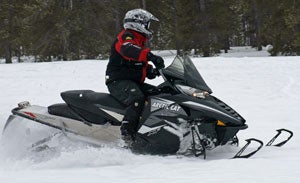 Arctic Cat’s collaboration with Yamaha results in placing a potent 4-stroke triple on a sport-handling stretch-track Cat chassis.
Arctic Cat’s collaboration with Yamaha results in placing a potent 4-stroke triple on a sport-handling stretch-track Cat chassis.During those early years, collaborations, if not complete rebranding, proved common, especially at Outboard Marine, which owned both the Evinrude and Johnson snowmobile brands. By 1975 the sporty Johnson JX and Evinrude Skimmer models shared everything except name and graphic schemes. That was also the same season of the Arctic Cat El Tigre (with a 440cc Kawasaki engine) and the very similar Suzuki Fury with Suzuki power but an Arctic Cat chassis.
This Suzuki powered model could be considered to be a forerunner to the Cat and Yamaha symbiotic emergence. Others sharing major components but different brands include the 1976 Scorpion Brut and Massey Cyclone, or perhaps it could be called a Massey Cy-clone!
RESEARCH: 2014 Arctic Cat Snowmobile Lineup
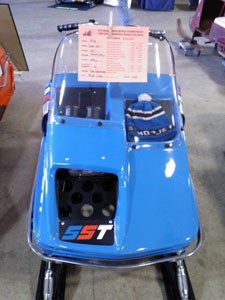 Before Kawasaki bought the Sno-Jet brand, the sleds could be powered by various engines including Hirth and Yamaha.
Before Kawasaki bought the Sno-Jet brand, the sleds could be powered by various engines including Hirth and Yamaha.Such partnerships date back to the earliest days of Polaris, when by 1957 the original Polaris pioneers struck an arrangement with a Canadian distributor to sell Polaris Sno-Travelers as Autoboggans, which were painted gold and rebranded with the Autoboggan logo. Based on this experience, in 1966 Polaris would manufacture Larson snowmobiles for the Larson boat company. Private labeled sleds for “mail order” companies sold by Sears, Roebuck, Montgomery Ward and even JC Penney would come out of either the Roseau or Thief River Falls snowmobile factories.
Yamaha’s sale of its engines to Arctic Cat mimics the Suzuki and Kawasaki deals from decades past. Even the collaborative effort of sharing an engine in a chassis to create the new Viper model has a basis in snowmobile history, but admittedly it’s decades old history and not all that many modern snowmobilers would be aware of how relatively common such practices were “back in the day.” Nor are they likely aware that barring some slight changes in historical events, all modern sleds could have been built by a singular manufacturer – Yamaha. Now that qualifies as true irony!




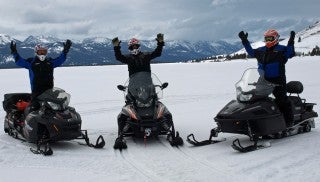
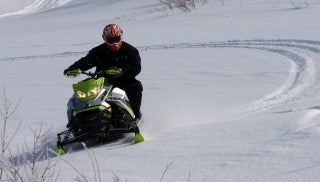


 Your Privacy Choices
Your Privacy Choices